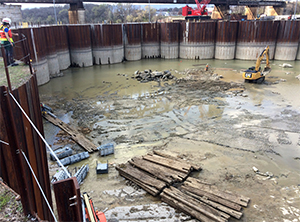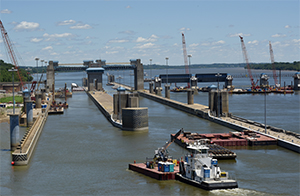Although President Trump has unveiled a record $1 trillion plan to rebuild infrastructure in America, the maritime community is extremely concerned about proposed cuts to several major inland waterway and port programs.
Trump’s fiscal 2018 budget, released on May 23, also includes a proposal for $1 billion in new user fees for the inland waterways over 10 years that would be paid for by commercial operators.
“We were surprised because, for an infrastructure president, to see a budget request like that was very disappointing,” said Debra Calhoun, senior vice president of the Waterways Council Inc. (WCI).
On the port side, the president’s budget eliminates the Transportation Investment Generating Economic Recovery (TIGER) program, a multi-modal grant initiative that last year awarded $61.8 million for dock, rail and road improvements. In addition, the Department of Homeland Security’s Port Security Grant Program, funded at $100 million last year, was cut 52 percent to $47.8 million, according to the American Association of Port Authorities. Spending from the Harbor Maintenance Trust Fund is now pegged at $965 million, significantly lower than the $1.3 billion approved in the fiscal 2017 omnibus budget.
On the inland waterways side, Trump’s budget calls for funding only one capital initiative: the Olmsted Locks and Dam Project on the Ohio River. “Under this proposal, workers at three priority navigation projects – Lower Mon, Kentucky and Chickamauga – will be laid off, with additional costs incurred from shutting these ongoing projects down,” said Mike Toohey, president of the Waterways Council Inc.
The U.S. Army Corps of Engineers budget proposed by the president is higher than President Obama’s fiscal 2017 request, but about $1 billion less than the $6 billion that Congress appropriated for fiscal 2017.
Industry leaders had been encouraged by Trump’s call for $1 trillion in infrastructure spending and his recognition of the importance of such projects. Calhoun cited the president’s June 7 speech at the Rivertowne Marina in Cincinnati, when Trump spoke at a podium with the Ohio River in the background. One of Ingram’s 12-barge tows carrying West Virginia coal was on the river behind the president.
“President Trump is out there talking about the importance of the inland waterways – we’ve never seen that before from any president since probably Franklin Roosevelt,” Calhoun said.
But Trump’s 2018 budget means the WCI has to rally its constituents in the maritime industry, along with farmers, coal miners and steelworkers, to advocate for restoring the cuts made by the president.
In his Cincinnati speech, Trump said 60 percent of United States grain exports travel the inland waterways to the Gulf of Mexico. “More than half of all the American steel is produced within 250 miles of where we’re standing right now. And its production depends on the inland waterway system,” he said.
The president talked about several instances when locks have failed to function, creating long delays for river traffic.
“These critical corridors of commerce depend on a dilapidated system of locks and dams that is more than half a century old,” Trump told the crowd. “And their condition, as you know better than anybody, is in very, very bad shape. It continues to decay.”
 |
|
Geologists with the U.S. Army Corps of Engineers inspect Chickamauga Lock in March to prepare for the excavation of the riverbed inside the cofferdam at Chattanooga, Tenn. Under President Trump’s infrastructure proposal, workers at the Tennessee River lock project and two others will be laid off, with additional costs incurred from terminating the projects, according to Mike Toohey, president of the Waterways Council Inc. |
|
Courtesy U.S. Army Corps of Engineers/Mike Arles |
“America must have the best, fastest and most reliable infrastructure anywhere in the world,” Trump said. “We cannot accept these conditions any longer.”
Another unpopular proposal in the president’s budget was a call for increased user fees for the nation’s inland waterways, which has been proposed before but rejected by Congress. The current diesel fuel tax of 29 cents per gallon was increased from 20 cents in 2014. The new fees would generate $108 million annually, roughly equal to what is collected from the current tax, according to the WCI.
“How can the administration, in good faith, ask commercial users – just one of many beneficiaries of the waterways system – to double their tax for the inland waterways when the administration proposes to use only 12.3 percent for the purposes for which the tax is raised?” Toohey said. None of the proposed new fees and funds from the existing tax will be spent on any project other than Olmsted, according to the WCI.
The user fees are part of Trump’s overall initiative for the private sector to fund more government operations. Early in the budget process, the WCI met with D.J. Gribbin, special assistant to the president for infrastructure policy, and it was made clear that the fees are part of Trump’s efforts to privatize the industry.
“We know (the White House is) looking at public-private partnerships to try and privatize the waterways, and pay for it in tolls,” Calhoun said. “We feel we are in a public-private partnership arrangement already. We are the only one who stepped up and made that agreement to raise fees,” she said, referring to the 2014 increase.
“The waterways don’t belong to any one group, or any one entity,” Calhoun said. “They are a national treasure and encompass multiple states. To make one user pay double what they pay now … is shirking federal responsibility and is fundamentally unfair.”
Robert Freeman, a government relations principal at Cozen O’Connor Public Strategies, said the work that the WCI and other groups are doing to highlight cuts to maritime programs in the federal budget is extremely important. “They want everybody to understand what these cuts would mean,” he said.
Part of the problem is that it is not clear yet how Trump’s philosophy on privatizing government will translate into specific spending. “A big part of that is the push to cut direct government spending and leverage private dollars,” Freeman said. “For transportation, that is a mantra we have been hearing for quite a while. We don’t know the details yet, and we certainly don’t know the details as they apply to inland waterways.”
Because the federal budget process is so lengthy and complicated, it is hard for any administration, including the Trump administration, to fully analyze and modify the budget in the first term. The process for the fiscal 2018 budget began two years ago, Freeman said. Trump’s budget was released on May 23, and the administration has not delved into a lot of specifics.
“They made some top-line changes, but there was not a whole lot of detail about how they are going to implement that and still maintain the waterways, and this is significant,” Freeman said. But Congress is already behind in the budget process, so “they cannot wait for details to support these numbers. They have to move forward with what they have.”
Transportation is usually a bipartisan issue, so Congress is not likely to accept the president’s budget proposal for maritime issues. “A lot of representatives have inland waterways they care about,” Freeman said.
On July 12, the House Appropriations Committee approved a fiscal 2018 budget that restored many of the cuts proposed by the president. The Army Corps of Engineers budget was raised to $6.2 billion, a $1.2 billion increase from Trump’s budget. The Corp’s construction account was increased $677 million from Trump’s budget to $1.7 billion. And the Corp’s operations and maintenance account was funded at $3.5 billion, a $419 million increase.

